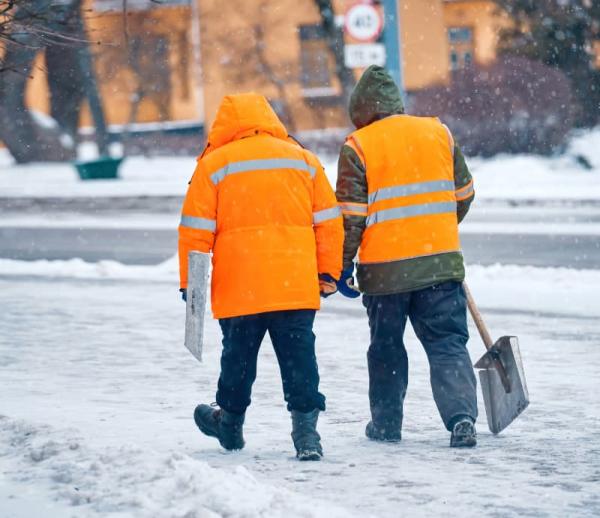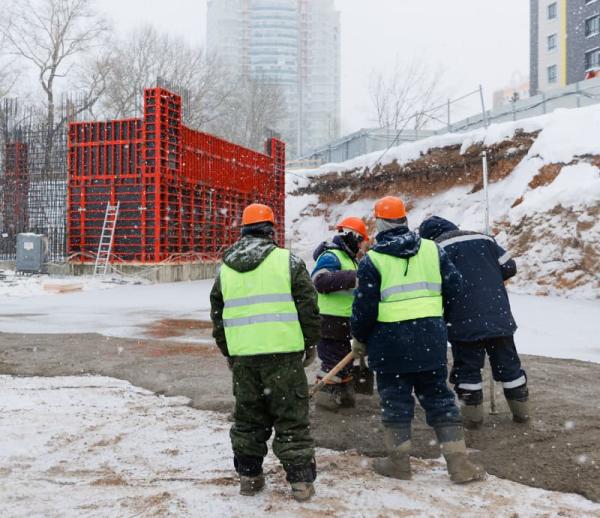Select the right high-visibility clothing
Choosing the right gear means going beyond just bright colours like yellow or orange – you’ll need to choose garments that meet EN ISO 20471 standards for reflectivity and ensure they are suitable for cold, wet conditions.
Hi-vis jackets and thermals or base layers are ideal for combining warmth with visibility. Plus, any garments with additional reflective strips on the arms, legs, and shoulders are particularly effective in ensuring your staff remain visible from all angles. As well as the visibility factor itself, the fit is really important too – ensuring your staff wear properly fitted gear can also prevent loose clothing from becoming a hazard.
Minimise outdoor night work where possible
Night-time working is inherently riskier due to limited natural light, plus the fact that it can sometimes get even colder after dark. So while we recognise it might not always be possible, one good way to protect your staff from the worst of the risks is to minimise or avoid outdoor work entirely. Wherever possible, it’s worth moving non-essential tasks to daylight hours when visibility is at its peak.
If you do have any jobs that absolutely have to be performed after dark (and it’s a reasonable guess that you’ll have at least a few), then make sure to undertake thorough risk assessments, which should identify potential hazards and recommend additional measures to mitigate them. Using light towers or portable floodlights to illuminate work areas can make a significant difference. It’s also a good idea to ensure that your staff are equipped with personal headlamps or reflective armbands to ensure they remain visible when moving between locations.
Tiredness is also a factor, especially if any of your team look likely to be working well into the night. Properly managed shift patterns can help to ensure that everyone alert during night work, further reducing the risk of accidents.
Install extra lighting solutions
Relying solely on hi-vis clothing is not enough when visibility is severely reduced – you could always do with effective lighting solutions. Personal lighting tools – like clip-on LEDs, torches, or rechargeable headlamps – can all provide your staff with portable illumination that maximises their safety. (These are especially useful in areas where fixed lighting is unavailable or difficult to maintain.)
For broader site visibility, you can use floodlights, motion-activated lamps, and static light towers, ideally strategically positioned to cover high-traffic or hazardous zones. Reflective equipment such as cones or illuminated signage can be deployed to alert drivers, pedestrians, and other staff to potential dangers. It’s also not a bad idea to consider using lights with adjustable angles to target specific areas. And of course, you’ll need to ensure that it’s all properly maintained, so you can have peace of mind against any failures at critical moments.
Check high-visibility gear regularly
This is one that a lot of people tend to forget – hi-vis clothing is only as effective as its condition. Reflective strips can become worn or dulled if they’re not cleaned regularly, and dirt can significantly reduce their brightness. Frequent checks of all hi-vis gear are essential to ensure it remains fit for purpose.
Before each shift, it’s worth implementing a standard practice of your team inspecting their clothing for damage such as tears, fading, or peeling reflective strips. That way, you can catch any issues and address them immediately, either through cleaning, repair, or replacement. Here’s something to remember too – you’ll need to wash any high-vis garments with non-abrasive detergents, as harsh chemicals can degrade their performance. Don’t forget to have spare hi-vis gear on hand to ensure that your team can replace any item that becomes compromised during their shift.
Stay ready for sudden weather changes
It’s no secret that winter weather can change rapidly, often turning manageable conditions into hazardous ones in moments. That means your staff need to be prepared for sudden shifts such as snowstorms, heavy rain, or dense fog that can significantly reduce visibility and create other safety risks.
Having appropriate weather-proof clothing on site is a must – so that includes fleece jackets, bodywarmers or gilets, and thermal gloves. It’s also sensible to ensure that at least one person on your team is equipped with extra supplies (especially on remote work sites). This might include torches, extra batteries, reflective tape, and even portable shelters, depending on the nature of the work. You can support preparation efforts by providing weather alerts and updates through apps or on-site communication systems, allowing teams to react quickly. Ultimately, simple steps like that can make all the difference when conditions worsen unexpectedly.
There’s a lot of ideas there – we’ll leave you to decide which ones you want to implement for your team! And if you ever need help with equipping them with new workwear, that’s exactly where we can help at City Workwear. We provide a wide range of individual garments, including workwear jackets, thermals and trousers. What’s more, we even provide specialised Winter Bundles and Hi-Vis Bundles, so you can enjoy a full range of workwear at maximum value.
(We also provide a FREE workwear printing and embroidery service and FREE delivery for orders over £150!)






